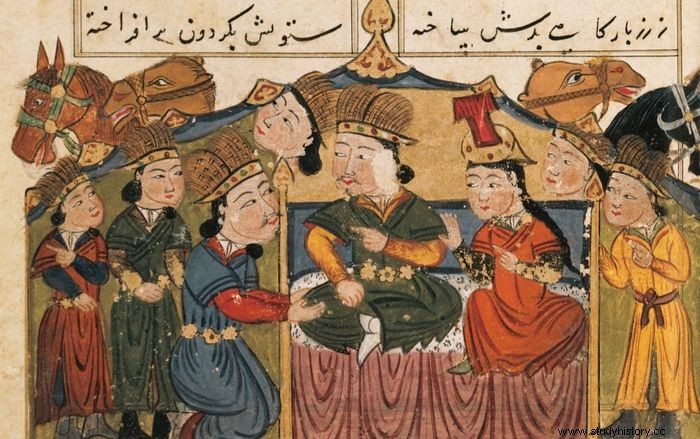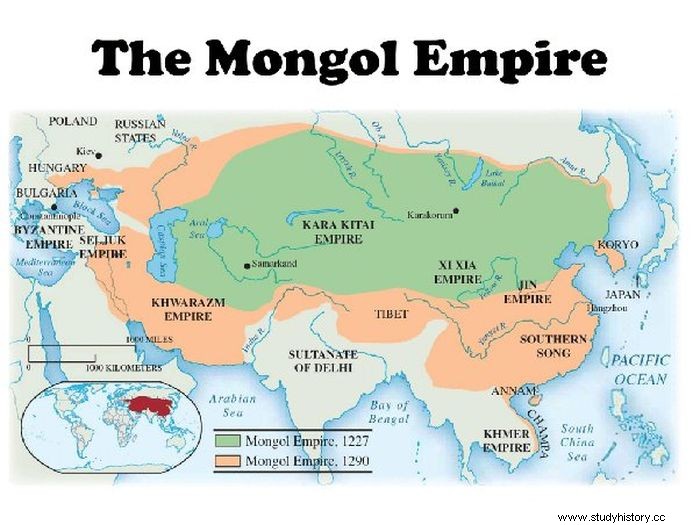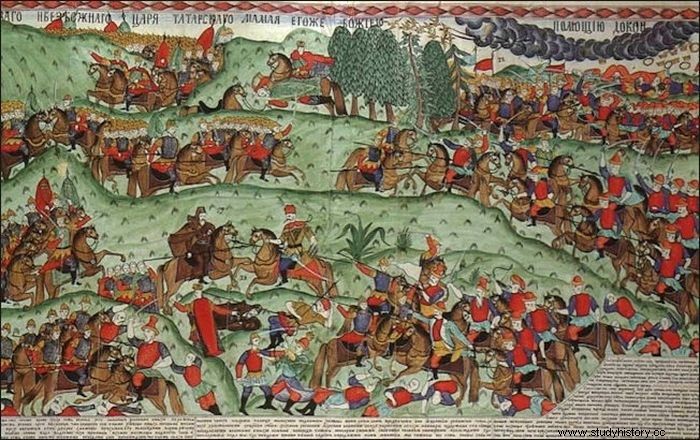Genghis Khan founded the Mongol Empire and ruled it from 1206 until his death in 1227. After uniting the Mongol tribes, he was given the title Genghis Khan, meaning universal ruler. Genghis Khan, also known as Chinggis, Chingis, Jenghiz or Jinghis, was born in 1162 near Lake Baikal in Mongolia. His original name was Temüjin, often spelled Temuchin.
Genghis Khan was a Mongol warrior ruler and one of the most famous conquerors in history. He united tribes into a single Mongolia before expanding his empire beyond Asia to the Adriatic. Despite his enormous achievements and fearsome reputation, we know little about Genghis Khan. For example, there is not a single true portrait of the man left today. All his existing pictures were made after his death or by strangers. Furthermore, the Mongols lacked a writing system until Genghis Khan took control of the Uighurs. As a result, many of the posts about him who survived were written by foreigners.
Genghis Khan's Early Life

Genghis Khan was named Temujin when he was born. Many tribes and tribal groups dominated Mongolia over time. Yesukai, his father, was the lord and chief of 40,000 XNUMX tents or households. Hoelun, Temujin's mother, had been kidnapped by her father's clan and forced to marry Yesukai, as was typical in Mongolia. So the name Temujin was given to the kid in honor of his father's victory over an opponent named Temujin.
When he was nine, Temujin was engaged to Börte, the 10-year-old daughter of Dai Sechen, the chief of the Jungirat tribe. Temujin lived with his father-in-law for a while. Yesukai, Temujin's father, died of poisoning at some point, and Temujin came home to discover his father's death. As many of his father's supporters fled from them, the family's authority was diminished.
Temujin, his family and his remaining followers were forced to scrape out a livelihood on marginal pastures. They also had to fight against robbers and Yesukai's former enemies who wanted to kill his family.
Things got much worse when a rival clan chief kidnapped Temujin. This happened due to an incident in which Temujin killed one of his oldest half-brothers, Bekter. Nevertheless, Temujin was able to escape during the night and gathered the few remaining faithful supporters of his father. He also teamed up with Toghril, chief of Kerait, a tribe his father had previously helped.
Temujin's leadership and fighting skills soon gave him victories over local enemies, and his army swelled in strength. A tribal chief was known for cooking his prisoners in 70 large pots throughout the battle. But on the other hand, Temujin proved to be unstoppable. By forming a network of alliances, he was able to unite most of the nomadic tribes that roamed the grasslands of Central Asia.
Genghis Khan's ascension to the throne
After a few years, Temujin decided that he was strong enough to return to Dai Sechen and marry Borte. But unfortunately the Merkit tribe took Borte in a raid. To release her, Temujin needed help from his friends Jamuqa and Toghrul. During this period, Temujin brought the nomadic, formerly always competing Mongol tribes under his control by political manipulation and military force. This act happened because of his wife's kidnapping. Eventually, he got his bride back from the rebellious tribe.
According to Chinese historical accounts, Temujin was taken by the Jin dynasty, which controlled part of China and held captive for several years. However, it is unclear whether this is correct or not.
Temujin united with Toghrul around 1200 and planned a battle against the Tatars, which they defeated in 1202. After Temujin destroyed Toghrul's soldiers, the two had a battle, and Toghrul was killed. Temujin also fought with Jamuqa, whom he eventually killed. Eventually, Temujin conquered large parts of Mongolia in 1206, forcing the surviving tribes to recognize him as their leader.
Temujin won the war, eliminating all the remaining conflicting tribes between 1203 and 1205 and putting them under his control. Coronation of Temujin as leader of the great Mongol nation took place in 1206 and the Mongol Empire was born.
Building the Mongol Empire
Through complex espionage operations, the first great Khan was able to gain control of various people and understand his opponent better. With promises of amnesty and neutrality, he also used a tolerant approach to religion and local customs. This happened to persuade many people to follow his clue.
In the years following the conquest of Mongolia, Genghis Khan waged a victorious war against the Jin Dynasty, capturing Zhongdu, now Beijing, in 1215. He then focused on the West and penetrated deeper and deeper into Central Asia. Finally, with an army of 200,000 1219 soldiers, he carried out a victorious campaign against the monarch of Khwarezm in present-day Iran in XNUMX.
The medieval world was amazed at his quick victories. While his tactics, such as the compound bow, cavalry, and false retreats, were not new, he had to seek foreign assistance to learn how to conduct siege warfare. In addition, Genghis Khan innovated in management and organization.
After conquering lands outside Mongolia, he established a more complex administrative framework and a systematic tax system. Then he began to design a more stable structure that could contribute to a more orderly administration. He also held specialized official positions by recruiting captured Turks, Chinese and others.
To govern his new dominion, he developed a set of rules and regulations. For example, Genghis Khan made it a requirement to share the booty from his expeditions between the warriors. In return, they follow a strict training plan for hunting. These guidelines helped him keep the troops united even though they were far from home.
While notorious for his ferocity, Genghis Khan often instructed his warriors to honor holy men of different religions and not harm artisans or clergy. In addition, Khan personally accompanied a religious system centered on Mongolian shamanism.
Expansions of the Mongol Empire by Genghis Khan

Despite his many successful political and social advances, Genghis Khan was a destructive and threatening leader. With the unification of the Mongol and Turkish confederations on the Mongol plateau in 1206, he established the Mongol Empire in Central Asia. The Mongols then attacked Central Asia from the west.
The Mongol Empire's troops had stormed over and over from the Asian steppes by 1260. The destruction of ancient and great empires in the Middle East, Egypt and Poland exemplifies Genghis Khan's terrible side. Mongol invasions in China replaced the Sung dynasty with the Yuan dynasty at the same time. Many people in what is now India, Pakistan and Iran saw the great Khan as a bloodthirsty warrior who was preoccupied with destruction.
Expansion of the Western Xia Dynasty
The rule of the Western Xia dynasties over what is now northern China was on the southern border of the Mongol kingdoms. The Xia dynasty had a complicated relationship with the Jin dynasty, and even served as a subordinate state to Jin for a while until Mongol armies arrived.
Genghis Khan first planned a battle with Western Xia, waiting for the Jin dynasty's youthful, more powerful emperor not to come to their aid. His first attempt to gain power began in 1205. The year before, he was crowned the Mongol supreme emperor. His earliest attempt was on the basis of a thin political assertion. However, he knew that this territory would be an excellent starting point for defeating the Jin dynasty in the south and east. Despite initial difficulties in capturing the well-defended cities of western Xia, Genghis Khan forced their surrender in 1209 and 1210 with much siege warfare.
The Xia region benefited greatly from Genghis' persistent war tactics. While conquering territory in 1209, his second invasion of western Xia in the 1220s illustrated the destruction and slaughter of cities and populations that refused to follow his instructions.
Expansion of the Jin Dynasty
Genghis Khan used the same tactics and military prowess in the western Xia region when he conquered the larger and more powerful Jin dynasty in 1211 AD, and started a 23-year battle known as the Mongol-Jin War. Long before the Mongol invasions, the Mongol tribes demanded vassal homage from Jin kings along their common border. Some kings even promoted conflicts between these nomadic tribes to increase their influence along their northern border.
But when the conflict broke out during the first Mongol invasion, the tide turned towards this mighty dynasty. Jin's army commander made a tactical mistake by failing to attack the Mongols when the opportunity arose. Instead, he sent a Mongolian envoy. However, the envoy betrayed the Mongols and informed them that the army of the Jin dynasty was waiting for them on the opposite side of the Badger Pass. The Mongols killed hundreds of Jin warriors here, and started a long and exhausting conflict that would cost the province dearly.
Genghis Khan invaded and destroyed the Jin city of Zhongdu in 1215 AD. As a result, Emperor Xuanzong had to move his capital to the south, leaving the northern part of the empire to the Mongols. The siege of Caizhou in 1234 AD, which marked the end of the Jin Dynasty, was the last significant battle between Jin and the Mongols.
Despite the difficulties of the struggle and the use of siege and heavy cavalry tactics by the Mongol armies, the unifying and centralizing effects of the Mongol Empire provided an expanded trade route and exposed these Far Eastern territories to Western influence and products. In addition, more stability along the Silk Road made it possible for goods and ideas to cross great distances and formed a connection between Eastern European princes such as Russian territory.
Expansion of Kara-Khitan Khanate
In 1216-1218 AD. subjugated the Mongol dynasty Kara-Khitan Khanate, a Central Asian empire consisting of former nomads. Prince Küchlüg, who had converted to Buddhism and oppressed the Muslim majority among the Khitans, ruled the khanate. This repression separated him from most of his people, and provided excellent conditions for Genghis Khan's invasion.
When Kara-Khitai attacked Almaliq, a city belonging to Mongol vassals, they alerted Genghis Khan. Genghis Khan deployed an army that destroyed Kara-Khitai in their capital, Balasagun, under the command of General Jebe, and Küchlüg fled. By proclaiming that Küchlüg's cruel policy of religious persecution had stopped, Jebe gained sympathy among the Kara-Khitan people. In 1217, when his army pursued Küchlüg to Kashgar, the people revolted and turned against him, forcing him to flee for his life again. Jebe chased Küchlüg into today's Afghanistan. In 1218, a party of hunters captured Küchlüg and brought him over to the Mongols, who quickly executed him, according to the Persian historian Ata-Malik Juvayni.
With Küchlüg's death, the Mongol Empire gained control of Kara-Khitai and its environs. The Mongols established a stronghold in Central Asia, and immediately bordered the Greater Iranian Khwarazmian Empire. Relations with the Khwarazms gradually deteriorated, resulting in a Mongol invasion of the region in 1219.
Expansion of the Khwarazmian Empire
Shah Ala ad-Din Muhammad ruled the Khwarazmian Empire in the early 13th century. Genghis Khan noticed Khwarazmia's potential as a commercial trading partner for Silk Road and sent a caravan to establish official trade relations with the empire. On the other hand, a Khwarazmian governor attacked the caravan and said it included spies. So instead of meeting the governor, Genghis Khan sent the second set of envoys to meet the shah in person. The Muslim ambassador was beheaded, and they sent their heads back with the other two diplomats.
Genghis Khan of rage prepares one of his largest and most ruthless invasion expeditions, dividing 200,000 1219 men into three divisions. From 1221 to XNUMX AD. he invaded Khwarazmia. Jochi led the first division into the northeast, while Jebe led the second division into the southeast, forming a seaweed attack on Samarkand with the first division. Finally, Genghis Khan and Tolui led the third division from the northwest. On the other hand, the shah's army had no organization, which contributed to their downfall because the Mongols did not meet a coordinated defense.
The invasion of Samarkand, the capital of Khwarazm, was decisive, leaving the local population poor and in ruins. Mongolian soldiers enslaved or massacred civilians after conquering a city or territory, creating a new rule of law and emphasizing Mongol control. According to legend, Genghis Khan assassinated the Khwarazm governor by pouring molten silver into his ears and eyes. The Shah eventually fled instead of submitting, and he died shortly afterwards, probably because of the Mongols. The Mongol Empire stretched from the Pacific Ocean to the Caspian Sea when Genghis Khan died in 1227, an empire twice the size of the Roman Empire and the Muslim caliphate.
Expansion of the Far West
The Mongols crossed the Caucasus, Iran, Iraq, Syria and parts of Turkey. In 1260 and 1300, several Mongol invasions went as far south as Gaza, into the Palestine area. The siege of Baghdad in 1258, when the Mongols destroyed the city that had been the heart of Islamic authority for 500 years, and the Battle of Ain Jalut in 1260, when the Muslim Egyptians were able to stop the Mongol march for the first time.
Due to political and natural problems, such as the lack of adequate grazing land for their horses, the Mongols could never expand west of the Middle East.
Mongolian Tactics of War

The Mongol army was now cohesive, and it had many advantages over its larger and more powerful neighbors. They were superb archers with long-range composite bows and hardy soldiers. His soldiers could ride with little food or drink for several days. Their thick, agile horses were weapons in themselves, capable of withstanding extreme temperatures. The Mongols had both light and heavy cavalry, and each rider had up to 16 extra horses, which allowed them a wide range of maneuverability. Furthermore, the Mongols never denied the chance to use the enemy's tactics and technology for themselves.
They not only introduced furious mobility to Asian combat, but were also quick to master other forms of combat. Because of their adaptability, they also introduced siege warfare and the use of gunpowder missiles and catapults. As Khan's ministers and commanders came from more than 20 different lands, it was generally a strength to use the abilities and inventions of others.
Another advantage was that Genghis Khan knew how to exploit internal enemy divisions and revive ancient rivalries to undermine hostile coalitions, the knowledge that spies and merchants often gathered. In addition, successful officers can expect huge parts of the country to govern as they wish. At the same time, Great Khan allowed the collection of payments from the monarchs who happened to remain in power as Mongol vassals. In short, once mobilized, the Mongol hordes would be extremely difficult to restrain.
Genghis Khan's Death and Conclusion
On August 18, 1227, Genghis Khan died of an unexplained illness, perhaps caused by a fall from his horse while hunting a few months before. He besieged the capital of the Xia Empire, Zhongxing, in northwestern China at the time. His body was eventually returned to Mongolia for burial. But the site of his grave was kept hidden, a choice that has since sparked much debate. According to medieval traditions, the tomb was located near the sacred mountain Burkan Kuldun.
Genghis understood that his heirs would fight to control the Mongol Empire after his death, so he had planned. Jochi, Chagatai, Tolui, and Ogedei, his sons, were to rule a khanate each. Ogedei, his third son, became the next great khan in 1229, until his death in 1241. The next great step forward took place during the reign of Kublai Khan (1260-1294 AD), the grandson of Genghis Khan. He conquered much of what was left of China from 1275 and brought the Song Dynasty to an end in 1279. In China, Kublai declared himself emperor of the new Yuan dynasty. As a result, the Mongols would completely conquer China over the next two decades. The Mongol Empire would fight other campaigns and eventually become one of the world's largest empires.
